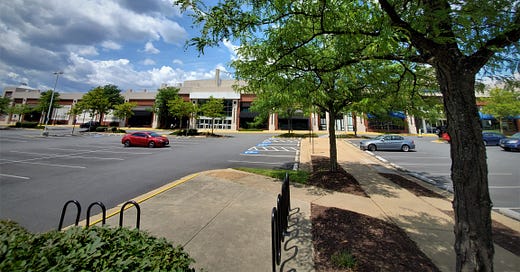As I’ve been driving around and exploring places, one of the interesting things I’ve run into is trouble parking. Not trouble finding a parking space—in the suburban areas I’m usually in, there’s no shortage of spaces. I almost never see a full lot, let alone one with a line to get in or cars circling around inside. (With one notable exception, and it’s a place I’ll be doing a full post on.)
Rather, the issue is that there’s too much parking, but it’s all private and specific to disconnected strip malls or office complexes (or churches!) For me, specifically, this is just a minor inconvenience, because if I’m intending to explore a larger section of a commercial strip, I have to leave the car on a side street and walk back to the strip.
However, it’s more of an everyday issue in that it makes it pretty much impossible to walk in a suburban setting if you arrived by car (as most customers and visitors will.) As I noted in this photo essay for Strong Towns, where I walked nearly the full length of Fairfax Boulevard (U.S. 50 in the City of Fairfax), this means that most suburbanites barely even have an opportunity to explore their daily surroundings on foot. Most have no idea what it’s like to walk along a U.S. Highway with nothing but a few inches of grass separating you from traffic that approaches 50 miles per hour.
On a more mundane and less conceptual level, the private, specific nature of suburban parking, with no public lots and little centrally located on-street parking, also means that there’s no incentive or possibility to treat the commercial strip like a street, even if you want to. It’s not unusual to hit two or three different shopping centers or stores on a shopping trip, some of which may be near each other. But you’re technically risking getting your car towed if you walk off the property where you parked it.
What if these parking lots were treated as public and open? Or perhaps, like much on-street parking, with different rules at different times? For example, church lots near the commercial area could be for parishioners only during service times; strip mall lots could be for on-site customers during peak hours and public at other times. Same with office buildings (public on weekends), or temporarily vacant properties (public while vacant). Does the dentist’s office with one car in the lot or the restaurant only open for dinner really need its empty lot to itself all day?
Would this produce different behavior in terms of how people think about and interact with the commercial strip? If this approach to parking were implemented, would more people walk off to the shopping center next door? Would anybody do what I do, and actually just walk down the commercial strip itself a bit? The rules and design of suburbia seem to tell you not to do this, but maybe there’s a bit of a chicken-and-egg thing going on here.
Take a look at this photo. This is a strip mall next to the Reston Town Center, in Reston, Virginia. It’s largely vacant and there are grand redevelopment plans for the space, but for a couple of years—and probably for a few years to come—it’s mostly a sprawling parking lot.
Meanwhile, next door at the Town Center, expensive parking decks take up a huge amount of what would or could be actual development. Here’s the Reston Town Center, with the strip mall at the top left. The parking decks are virtually never all full either (they’re not even all visible on the satellite image, but see how many you can spot). What if the nearby strip mall parking, instead of banning walk-offs while sitting empty, could share with the Town Center traffic? What if one deck could have been squeezed out of the Town Center plan, and one more actual block of office, residential, or retail squeezed in?
In some ways, this would be a partial, stealth revocation of parking minimums, if parking were no longer designated for the actual businesses in the property. It would certainly raise zoning issues in many localities. Not to mention complaints from commercial landlords. But it’s also a distinct way of rethinking parking that I’ve rarely heard discussed.
I’m curious if anything like this has been proposed, as a small incremental reform towards allowing suburban commercial strips to behave a little bit more like streets, and allowing us to treat them that way.
Related Reading:






Sacramento does this, they manage the lots owned by the local SEIU chapter and charge for them at times when the SEIU does not need the parking. (https://www.cityofsacramento.org/Public-Works/Parking-Services/Lots-and-Garages/Rates -- this applies to the SEIU lot but there may be others). I do wish more cities or jurisdictions attempted to do this but I imagine there's liability/insurance issues that are much easier to overcome when you can charge for that parking like they can here. May be harder to do as free parking.
We know a non-profit theater company that is attempting to work out a tax-break strategy for the owner of a potential parking lot, now vacant and adjacent to the theater. So far, the landlord has had little need to develop the lot, but as three new commercial spaces he has developed in that neighborhood are set to open soon, the parking lot will become a reality. The non-profit hopes to convince the landlord that if he offers short-term use of the lot for off-hour theater activities occasionally, he could get tax breaks that would benefit him and reduce his costs. This may be a strategy that works for others in similar situations. It helps that the president of the theater non-profit also has his own insurance agency!